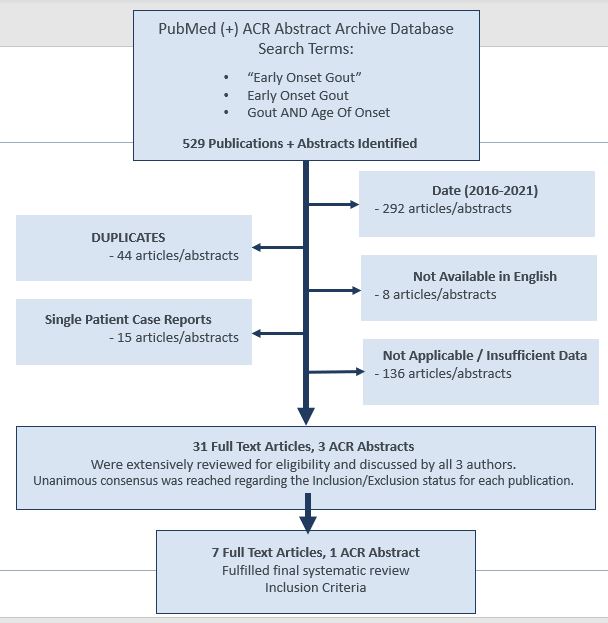Session Information
Date: Sunday, November 7, 2021
Title: Metabolic & Crystal Arthropathies – Basic & Clinical Science Poster I (0660–0682)
Session Type: Poster Session B
Session Time: 8:30AM-10:30AM
Background/Purpose: Data suggests that the number of patients with early-onset gout (EOG), defined as patients under the age of 40 years, is increasing1. There is a paucity of data related to the clinical features, comorbidity profile, and response to treatment for patients presenting with EOG although international guidelines recommend urate lowering therapy be initiated at time of diagnois2,3.
Methods: A systematic review of the literature was conducted to examine publications and abstracts providing insight into the overall profile of EOG patients. A comprehensive search was conducted in the PubMed Database and ACR Archived Abstracts to identify relevant publications. Identical Search Terms were used in both databases, and a full review of EOG literature identification and inclusion/exclusion criteria can be found in Figure 1.
Results: The search retrieved 529 references (Fig 1). 31 articles and 3 abstracts were reviewed for eligibility. 8 publications were included in the final review. 5 focused on the clinical characteristics of EOG patients; 3 of the 5 were retrospective or cross-sectional analyses comparing EOG patients to a group of Common Gout (CG) patients. All three cohorts with comparisons produced consistent insights into the clinical manifestations of EOG patients: either gout preceded the onset of cardio-metabolic comorbidities or fewer comorbidities were present at the time of gout diagnosis in EOGs; a large majority of EOGs had preserved renal function; EOGs had more severe joint disease (assessed by flare rates/polyarticular disease); finally all reported EOGs were less likely to achieve a target serum urate (SU) < 6 mg/dL or had higher SU levels at baseline compared to CG patients (Table 1). The remaining 3 publications focused on EOG patients’ genetic predisposition for acquiring gout, concluding both ABCG2 and non-ABCG2 dysfunctional polymorphisms are more prevalent and likely contribute to the development of EOG.
Conclusion: The data reviewed examining EOG vs. CG comparators all produced consistent results. EOG patients are recalcitrant to ULTs, and present with more severe disease compared to CG patients.
SNPs (ABCG2, and other common and rare SNPs) that encode genetically dysfunctional urate transporters likely play an extensive role in development of EOG. The reviewed clinical and genetic data support the theory that gout operates within a “Common Disease, Multiple Common and Rare Variant” model.
EOG patients presented with less cardio-metabolic comorbidities upon diagnosis, suggesting a temporal separation between EOG diagnosis and development of other comorbidities. This suggests a window of opportunity to impact the development of comorbidities associated with gout.
To cite this abstract in AMA style:
Amatucci A, LaMoreaux B, Bulbin D. Early-Onset Gout (EOG) Patients Are an Important and Recalcitrant Phenotype Warranting Further Investigation: A Systematic Review [abstract]. Arthritis Rheumatol. 2021; 73 (suppl 9). https://acrabstracts.org/abstract/early-onset-gout-eog-patients-are-an-important-and-recalcitrant-phenotype-warranting-further-investigation-a-systematic-review/. Accessed .« Back to ACR Convergence 2021
ACR Meeting Abstracts - https://acrabstracts.org/abstract/early-onset-gout-eog-patients-are-an-important-and-recalcitrant-phenotype-warranting-further-investigation-a-systematic-review/


